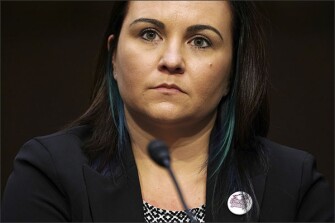
Though Katherine Posada’s honors English students survived a Feb. 14 shooting at Marjory Stoneman Douglas High School, they don’t carry the scars that some of their younger peers do, she told members of the Senate Judiciary Committee Wednesday.
Those older students huddled in the corner of her Parkland, Fla., classroom during the shooting, away from the view of a small window in the doorway. They learned that a gunman was in another building on campus, killing 17 people with an AR-15 rifle, from text messages as they waited for police to arrive and escort them to safety.
The affected building held mostly freshman classes, and Posada can see the effects of trauma in her freshman students who were closer to the violence that day.
“Many of them saw friends die and had to step over bodies and pools of blood to get out of their classrooms,” she told the committee at a hearing about school shootings. “Loud noises—even the bells between classes—make them jump.”
Since the shooting, the public face of Parkland has been the vocal students organizing a national movement for tougher gun laws; Posada spoke on a day when their influence inspired students around their country to walk out of their schools in protest. But students, especially those who were closest to the shooting that day, saw and heard things that will stay with them forever, she said.
One girl asked if she could stand with her back against the wall because “she didn’t feel safe sitting in a desk in the middle of the room, not knowing what was behind her,” the teacher said.
When Miami Heat player Dwyane Wade, who was a hero to one of the victims of the shooting, recently paid a surprise visit to the school, the screams of excitement triggered some students, Posada told senators.
“They were too similar to the screams of terror they heard just a few short weeks ago,” she said. “These kids will be dealing with this trauma for years to come.”
Survivors of previous school shootings have carried similar scars. After the 1999 shooting at Columbine High School in Littleton, Colo., students didn’t want to eat Chinese food, which is what the cafeteria was serving that day, their principal has said.
In Parkland, the school and the community have been mindful of the complex ways survivors process trauma. Teachers reintroduced students to classes slowly, starting on a modified schedule and filling classrooms with therapy dogs to comfort them as they adjusted. Counselors remain on site for students to process their grief and fears, and the U.S. Department of Education has provided a $1 million grant to help with ongoing emotional and psychological recovery efforts.
Posada spoke alongside the father of one of the victims, law enforcement officials, and a representative for internet companies as lawmakers probed the causes of the shooting and what could be done to prevent future violence. Read more about their discussion in this Politics K-12 post.
Photo: Katherine Posada, a teacher at Marjory Stoneman Douglas High School in Parkland, Fla., testifies before the Senate Judiciary Committee about school shootings and school safety, on March 14 on Capitol Hill. --Jacquelyn Martin/AP
